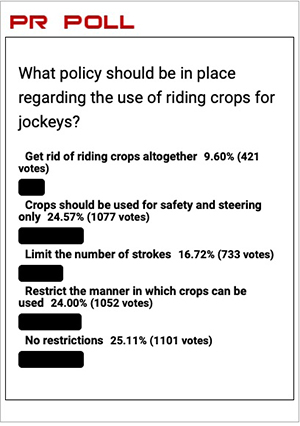If your time to you is worth savin'
Then you better start swimmin'
Or you'll sink like a stone
For the times they are a-changin'.
— Bob Dylan
This change is inevitable.
The only question is when.
The catalyst for The Stronach Group’s (TSG) limiting the whip in American horse racing for safety and control purposes only was the 23 equine fatalities at the current race meet at Santa Anita Park.
Many in the racing industry reject a correlation between whipping and horses’ breaking down. These people are missing the point. The media coverage of Santa Anita has shown some of the sport’s practices to be offensive to the public at large. Once the racing industry draws attention to itself, as it has with these horse deaths at Santa Anita, all of its warts become exposed for the nation to see.
Whipping is a wart. It needs to be eliminated.
My advocacy for racing without whipping is a plea, not a criticism.
I am 60 years old and have been involved in the horse racing business all of my adult life. It has been in just the last few years that my opinion on the use of the whip has changed. I think that most racing industry professionals of my generation have seen, over the course of their careers, no serious problem with the traditional use of the whip for encouragement.
I, like many others, supported recent whip reforms, including the use of the cushion crop and requiring a horse to respond to the whip before being asked for more. These steps have proved to be insufficient.
The song debuts
It was 1964 when Bob Dylan released what would become one of his most famous songs, the title track on the album Times They are a-Changin’.
That was a different era. Both for the country and for horse racing.
I grew up in western Massachusetts. According to the Daily Racing Form’s Annual Review, the racing calendar in New England in 1964 would be unrecognizable to most any millennial.
Here is a listing of some of the 1964 race meets.
Green Mountain Park (VT) – 121 days
Lincoln Downs (RI) – 84 days
Narragansett Park (RI) – 66 days
Rockingham Park (NH) – 60 days
Suffolk Downs (MA) – 66 days
Those five track had been the foundation for a strong and vibrant New England racing circuit for generations. All are distant memories except for Suffolk Downs, which will close its doors forever after racing only six days this year. Suffolk Racecourse (SSR), the company that operates racing and simulcasting at Suffolk Downs, sold the property in 2017 to real estate developers.
The list of bygone tracks is not limited to New England, of course.
Only fond memories remain of other tracks operating in 1964.
Here is just a sampling of such Thoroughbred tracks: AK-SAR-BEN, Atlantic City, Balmoral, Bay Meadows, Detroit Race Course, Garden State Park, Hagerstown, Hazel Park, Hollywood Park, Longacres, Playfair, Raceway Park, Sportsman’s Park, Washington Park, and Yakima Meadows.
I don’t mean to suggest that there is an absolute cause and effect between whipping and the decline of the sport of horse racing. I do believe, however, that the perceived brutality of whipping a horse is emblematic of a sport that has lost touch with the sensitivities of the American public at large – which has fueled its subsequent decline.
Where does the racing industry stand?
Just last week the Paulick Report issued results of an online survey that encapsulates the racing industry’s attitude toward whipping. The question is straightforward: What policy should be in place regarding the use of riding crops for jockeys?
As you can see by the results below, those involved in the business disagree on the appropriate use of the whip.

The industry’s next move
As I said, this reform is inevitable. It will happen now, or it will happen later.
Will the industry try to find a middle ground to appease its various special interest groups or will it act in the short-, medium-, long-term interest of the sport and embrace the Stronach whipping reform now? The Stronach reform would most likely stand the test of time. Once implemented nationally, this issue would not resurface.
If the public outrage regarding the Santa Anita fatalities is not enough to spur the racing industry to finally put this issue to rest, we will just have to wait a little while longer.
Another catalyst is right around the corner.